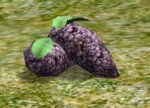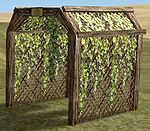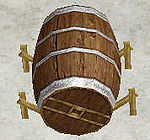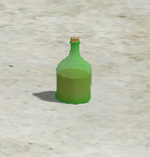The Wiki for Tale 7 is in read-only mode and is available for archival and reference purposes only. Please visit the current Tale 11 Wiki in the meantime.
If you have any issues with this Wiki, please post in #wiki-editing on Discord or contact Brad in-game.
Difference between revisions of "Wine"
(→Other Wine Attributes: Thin means vintage range of all flavors not there, it's not the flavor's intensity.) |
|||
| Line 230: | Line 230: | ||
* See the [[Wine/Flavors|Known Flavors]] table. | * See the [[Wine/Flavors|Known Flavors]] table. | ||
* Wines low in acid and alcohol will eventually lose their flavour the longer they are kept (information provided by Tedra, the exact formula for determining the life of the wine is unknown.) | * Wines low in acid and alcohol will eventually lose their flavour the longer they are kept (information provided by Tedra, the exact formula for determining the life of the wine is unknown.) | ||
| + | * Whilst the flavours remain static in the world, a vineyard placed at a slightly different place in the same coordinates may pick up a different set of flavours if the flavours are at the edge of their reach. | ||
| + | ** ''For example, a vineyard built at 1270, 2830 but to the right of the coordinate (since a coordinate is quite big, and can hold a couple vineyards), this will produce Banana and Melon (as does every vineyard built for a dozen more coordinates to the right), a vineyard built at the at 1270, 2830 but to the left of the available coordinate did not produce either of those flavours. [[User:Silden|Silden]] 04:24, 26 October 2016 (EST) '' | ||
==== Detecting Flavors ==== | ==== Detecting Flavors ==== | ||
Revision as of 09:24, 26 October 2016
| English | Deutsch | français | magyar | Türkçe |
Source
Wine is an alcoholic drink (although it can be made with 0% alcohol) made with Grapes harvested from a Vineyard and allowed to ferment in a sealed Wine Barrel.
Cost
To barrel:
- 21 Grapes
- 1 Wine Barrel
- 1 Barrel Tap
To bottle:
Use
When drunk at a Ceremonial Tasting Table, wine gives palate increases and allows one to fill a Wine Notebook. This allows one to raise their perception.
Research and Tuition
- 30 required for Ambrosia Brewing research (At least 12% alcohol and 2 vintages old)
- 30 required for Distillation research (At least 6% alcohol)
- 30 required for Distillation research (At least 12% alcohol)
Tending Quick Links
- Amusement, available in Eastern Grounds
- Appreciation, available in South Egypt
- Balance, available in Midland Valley
- Contemplation, available in
- Distraction, available in Sinai
- Frivolity, available in
- Wisdom, available in River Plains, Seven Lakes
- Player made Vine strains (Work in Progress)
- Blank Vine Tend Table
Phenotypes
| Vine | Starting Grapes | Phenotype |
|---|---|---|
| Amusement | 11 | GGVV |
| Appreciation | 12 | QQQ |
| Balance | 8 | ACGQKS |
| Contemplation | 10 | QQKK |
| Distraction | 12 | GG |
| Frivolity | 8 | ACCSS |
| Wisdom | 9 | KKK |
- Tends by Phenotype, for determining phenotypes and resultant tend tables of crossbred vines
- Finding Your Phenotype, a guide
Wine on the Vine
Vine Cuttings
Vine cuttings can be obtained from the University of Worship in regions that have unlocked Viticulture.
- You must pay 1 Tilapia Fish for a cutting it apparently must be fileted.
- A new cutting becomes available about every hour. Unclaimed cuttings will be stored.
- It is possible for the university to be out of cuttings when you ask for one, if a lot of people have recently taken one. You still lose your fish, however.
Vine cuttings may also be taken from your vineyard every two hours (even if you do not tend the vine at that time). Thus, you may find it easier to get a cutting directly from another player if it has been out in Egypt for a while.
Once you have a cutting, you may Plant it on the vineyard. You will see the vines appear, and clicking on the vineyard again will reveal the starting grapes for that vine.
Vine Attributes
Each vine has seven key attributes or statistics that are affected by your tending methods.
| Attribute | Abbreviation | Notes |
|---|---|---|
| Acid | A | Determines how long flavours remain while bottled. Lower acid wines lose their flavour the more they age. The exact formula for determining how long wine will last is unknown. |
| Color | C | In combination with the vine's genetics (see below), determines the hue of wine made from these grapes (though again, the exact role is not clear). |
| Grapes | G | Each cutting type will have a set number of starting grapes, each time it is planted. If the grape count ever reaches 0, the vine will die. |
| Quality | Q | Determines the potential quality of wines made from these grapes. Higher quality wines will reveal more flavors and retain these flavors longer. |
| Skin | K | May be involved in the production of Tannin in the barrel (see below). |
| Sugar | S | Sugar is converted to alcohol in the barrel. |
| Vigor | V | How much "life" is left in the vine. If Vigor ever reaches 0, the vine will die. |
Vineyard States
Each vineyard will cycle through a specific sequence of states, as a vine is tended. This cycle will be the same for the life of the yard, and thus may be recorded to aid in planning/tending.
There are seven possible vineyard states:
| Short | Long | Full Text |
|---|---|---|
| Sa | Sagging | The vines are sagging a bit |
| W | Wilting | Leaves are wilting |
| M | Musty | A musty smell can be detected |
| F | Fat | Stems look especially fat |
| R | Rustle | Leaves rustle in the breeze |
| Sv | Shrivel | The grapes are starting to shrivel |
| Sm | Shimmer | Leaves shimmer with moisture |
Tending Methods
Vines may be tended once per hour, using one of seven methods:
| Short | Long | Full Text |
|---|---|---|
| AS | Aerate | Aerate the soil |
| MG | Mist | Mist the grapes |
| PO | Pinch | Pinch off the weakest stems |
| SL | Shade | Shade the leaves |
| SV | Spread | Spread out the vines |
| TV | Tie | Tie the vines to the trellis |
| TL | Trim | Trim the lower leaves |
Putting It All Together
Each combination of vineyard state and tending method will make a specific set of changes to the value of the seven vine attributes. These changes may be positive or negative.
- For example, with a Balance vine, if you "aerate" a "sagging" vineyard, you will see:
- Acid +8, Color +3, Grapes +0, Quality +2, Skin -3, Sugar +0, Vigor -10.
Because these numbers will be the same each time this yard state/tend method/vine combination is used, they are collected in Tending Tables on the wiki for everyone to use.
The specific tend method you choose at any tending will depend on your own goals for that vine. In general, though, the following are good guides:
- If acid is too low, older vintages may end up losing their flavor.
- Higher grapes is an obvious goal, to make more bottles of wine. Again, if grapes ever reaches 0, the vine will die.
- If wine quality is too low, top tier flavors (see below) may not be revealed. Zero quality wines will always be "thin," with no detectable flavors.
- Higher sugar allows higher alcohol levels in the barrel. Thus, if you plan to bottle the wine as "grape juice" (alcohol 0%) for flavor testing, you do not need to worry about ensuring sufficient sugar in the grapes. Alcohol also plays a part in the longevity of the wine while it is bottled.
- If vigor ever reaches 0 or below, the vine will die.
Harvesting
Some vintners will continue tending until vigor is as low as possible (i.e. there is no tend available that won't kill the vine). Others may choose to tend until vigor reaches a certain range (e.g. in the 50s, etc.), in order to cycle through harvests more quickly.
In either case, once you Harvest the Grapes, they will be placed in your inventory (sequentially numbered by how many harvests you have done). They will remain fresh for 2 teppy days (in inventory, storage or an unsealed barrel). After that, they will spoil and cannot be used.
Notes:
- You may check harvest information on your grapes at any time by holding them in your inventory, and using the Self -> Special -> Examine Grapes menu.
- It is a good idea to check the "confirm harvest" option in your interface controls, to prevent mis-clicks while tending or taking vine cuttings.
Wine in the Barrel
Filling/Sealing
To use a Wine Barrel, you must have grapes in your inventory.
- For every 21 grapes you put into a barrel, you will later get 1 bottle of wine out. (Remainders will be lost, but may be used to affect the wine stats.)
- After you have loaded the barrel with your Grapes, you must then Crush the grapes and seal the barrel. Doing so requires one Barrel Tap (in inventory).
- You will then be asked to name this vintage of wine. This name will be carried through to the bottled wine. Initial naming of the wine does not require ink or paper. Recent improvements now allow you to rename the wine while still in the barrel. This requires 1 Quill, 1 Papyrus Paper and 1 Ink. The Quill is not consumed by the process.
- Once the barrel is sealed, the grapes will begin to ferment into wine.
Barrel Attributes
You may Siphon a sample of the wine at any time to check its progress, without affecting the wine.
- Alcohol is converted from residual sugar over time.
- Residual Sugar = Grape Sugar/2
- Tannin conversion rates are believed to be determined by Color*Skin.
- Acid is equal to Grape Acid/10 and will not change during fermentation.
The barrel will also show the Hue of the wine (e.g. White, Light Red). Possible hues are:
- White
- Rose
- Light Red
- Red
- Dark Red
- Purple-Red
- Purple
- Deep Purple
Fermentation
As the grapes sit in the sealed barrel, they will slowly ferment (convert sugar into alcohol).
- Each 0.1% of Residual Sugar that ferments equals .2% alcohol (eventually).
- Fermentation rates are determined by initial Residual Sugar. Higher sugar grapes will show a more rapid initial rise in alcohol %, but the curve will slow after 10% (such that both low and high sugar grapes will reach 12% in about the same time).
- The minimum amount of time for any wine barrel to reach 12% alcohol is about a RL week. (13% wines will take about one RL month, and 14% wines take about 3 RL months.)
- In order to reach 12% alcohol, you need at least 6% Residual Sugar, or a Sugar score on your grapes of 12.
Note: There appears to be some rounding of these numbers that may affect whether they meet wine notebook requirements. Thus, if trying for a 12% alcohol wine, it is safest to bottle the wine when alcohol = 12.1%.
Bottling
When the wine has fermented sufficiently, you may bottle it.
- You must have enough Empty Wine Bottles in inventory for the number of bottles in the barrel (again, 21 grapes = 1 bottle).
- The wine will be named the same as the barrel from which it came.
- The vintage of the wine will be set by the current Egypt vintage.
- Bottled wine may be stored, given, traded, dropped etc. as any other portable item.
Wine in the Bottle
Understanding Vintages
Egypt's vintages started at vintage 0 in Akhet I of the first year of the telling, and a new vintage happens on the first of every game month (about every 10-11 days in RL time).
- The current vintage in Egypt is shown when you siphon a taste from a barrel. However, an individual wine's vintage is not locked-in until it is bottled.
- Bottled wine has a specific vintage, set when bottled. The difference between that vintage and the current Egypt vintage is considered the "age" of the wine.
- Immediately after bottling, wine is thus 0 vintages old.
- This age of the wine is used to satisfy wine notebook requirements (e.g. "wine at least 3 vintages old").
- Wine age also plays a role in which flavors that can be detected (see below).
- The higher the vintage number on a bottle of wine, the younger the wine is.
Using the Table
A bottle of wine may be opened at a Ceremonial Tasting Table. Each bottle contains seven glasses of wine. To drink, click on a wine glass on the table, fill it, and then drink it.
You will receive a pop-up showing the results of your tasting, and any wine notebook or palate points earned.
The table can be cleared to allow another bottle to be opened. This can be done even if there is wine left in the bottle or in a glass. The empty wine bottle will be stored in the table and can be taken (if the player has permission).
Understanding Flavors
Each vineyard will have a specific set of flavors that it will imbue in its grapes. These flavors will be revealed in the wine based on a combination of vineyard location, wine age and quality, wine glass quality, and your own palate ability.
Vineyard Flavors
- Each vineyard can have up to 3(?) flavors.
- Wines with grapes from more than one vineyard can show up to 7(?) flavors total.
- Each flavor has three "tiers," somewhat akin to category, subcategory and specific flavor. For example: Fruit > Tree Fruit > Peach.
- Each of these tiers can count as a different flavor for the wine notebooks, the first time they are tasted.
- Each flavor appears in the wine at a specific age of the wine. If the wine has not aged sufficiently to reveal at least one flavor, it will present as "thin." For example:
- Peach can be detected as soon as the wine is bottled (age 0 vintages), but Apricot cannot be tasted til the wine is at least 1 vintage old.
- A wine with both Peach and Apricot flavors will show Peach at age 0 and both at age 1.
- See the Known Flavors table.
- Wines low in acid and alcohol will eventually lose their flavour the longer they are kept (information provided by Tedra, the exact formula for determining the life of the wine is unknown.)
- Whilst the flavours remain static in the world, a vineyard placed at a slightly different place in the same coordinates may pick up a different set of flavours if the flavours are at the edge of their reach.
- For example, a vineyard built at 1270, 2830 but to the right of the coordinate (since a coordinate is quite big, and can hold a couple vineyards), this will produce Banana and Melon (as does every vineyard built for a dozen more coordinates to the right), a vineyard built at the at 1270, 2830 but to the left of the available coordinate did not produce either of those flavours. Silden 04:24, 26 October 2016 (EST)
Detecting Flavors
- The quality of the wine glass will determine the maximum tier of flavor that can be detected. For example, a wine drunk from a low quality glass may only reveal the Fruit or Tree Fruit flavor tier, while the same wine from a higher quality glass may present as Peach.
- Your "palate" for wine will also affect your ability to detect more flavors.
- You may occasionally receive a notice that your palate has improved after drinking a wine. Your current palate level is not recorded anywhere, so take notes if you want to keep track.
- With no or low palate, you may not be able to detect the third tier of some flavors even in a high quality glass.
- With no or low palate, more subtle flavors may be masked by stronger ones.
- The quality of wine will also affect the ability to detect all three tiers for some flavors, or reveal them in the face of stronger flavors.
Other Wine Attributes
A wine will also have a flavor intensity, quality, and sweetness. Each of these may change at each vintage (wine age) change. (Listed from high to low below.)
| Flavor Intensity | Quality | Sweetness | ||
|---|---|---|---|---|
| Overflowing Bursting Intense Aromas Ample Amounts Displays Hints Fluttering |
Pharaoh's private collection Describe to grandchildren Moved to tears Historic Stupendous Luxury Spectacular Astonishing Stunning Graceful Very passable Hint of character Pleasant (thin wine) |
Pharaoh's dessert Mind boggling, syrupy Luxuriously sweet and haunting Honeyed dessert Luscious Light dessert Delicious Warm hint Fluttering Dry Hard wine, extremely dry |
Related Pages
Supplemental Guides
- Abbreviations
- Known Flavors
- Vineyards and Wine Guide by Pascalito and Ariella
- Finding Your Phenotype
- Calixes' Quick and Easy Guide to Making Wine (from T3)
- WilliamRobert's simulated tending charts (feedback most welcome)
Tools
Wine Guilds/Traders
- Egypt Wine & Beer - 7L cs (200 boards, 200 bricks)
Required By
Ambrosia Brewing, Distillation, Test of Festivals, Guilds/Festivals, Test of Ritual Mummification




